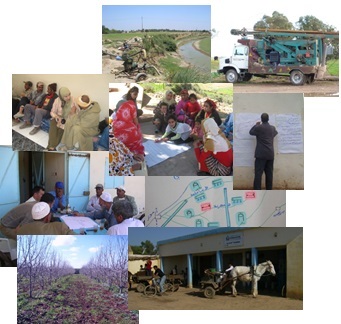Nassim Chahid, Zeine Zein Taleb, Mostafa Errahj, Nicolas Faysse
DOI : https://doi.org/10.60569/hsoas-a3
Numéro 10, dossier thématique oasis, juillet 2024
Résumé
Dans les oasis du Sud-Est du Maroc, les organisations de développement local ont souvent occupé une place centrale dans le développement rural. Au cours des deux dernières décennies, leur nombre a connu un accroissement remarquable malgré les défis auxquels elles sont confrontées tels que le manque d’autonomie financière et le faible accompagnement technique et stratégique. Partant de la curiosité sur l’importance du collectif dans la dynamique de constitution de ces organisations, notre article a pour but d’analyser les facteurs de réussite des organisations de développement local à travers la mesure de performance de l’action collective à l’aide d’une grille d’analyse co-construite avec les acteurs du terrain. Pour ce faire, nous avons identifié, lors d’un stage de développement réalisé dans les oasis de Todgha, des facteurs et indicateurs de mesure de la performance de l’action collective. Liés à l’origine des organisations, à leur gouvernance et à la nature de leurs activités, ces facteurs ont été regroupés dans une grille. Suivant un processus itératif et évolutif, cette grille a été d’abord élaborée et discutée avec trois organisations de développement local, puis validée avec 9 chercheurs ainsi que des acteurs du terrain (experts, agriculteurs, membres d’organisations de développement local, institutionnels). Dans un deuxième temps, la grille a été appliquée à deux organisations de développement local dans les oasis de Todgha. Les résultats montrent que la performance des organisations dépend de facteurs internes tels que les caractéristiques des membres et des leaders de ces organisations (bonté, persévérance, confiance…), et des facteurs externes comme leur capacité à saisir les opportunités de financements, de partenariat et de coopération. Appliquée à un contexte oasien, cette grille pourrait être utilisée et adaptée à d’autres contextes pour évaluer la performance des organisations.
Mots clés : Grille d’analyse, oasis, action collective, performance, Todgha
تحليل أداء تنظيمات التنمية المحلية اعتمادا على شبكة تحليل تم اعتمادها وتطبيقها على مستوى واحات تودغى بالمغرب
الملخص
في واحات جنوب شرق المغرب، تحتل تنظيمات التنمية المحلية غالباً مكانة مركزية في التنمية. وقد شهدت هذه التنظيمات زيادة ملحوظة خلال العقدين الأخيرين بالرغم من التحديات التي تواجهها: مثل نقص الاستقلال المالي وضعف الدعم التقني والاستراتيجي. وبهدف فهم أهمية المكون الجماعي في هذه الديناميكية، يهدف مقالنا إلى تحليل عوامل نجاح منظمات التنمية المحلية من خلال قياس أداء العمل الجماعي باستخدام شبكة تحليل تم بناؤها بالتعاون مع الفاعلين الميدانيين. تعتمد هذه الشبكة على عوامل ومؤشرات لقياس أداء العمل الجماعي تم تحديدها بشكل تشاركي مع مختلف المتدخلين في هذا الميدان على مستوى واحات تودغى. ترتبط هذه العوامل بشكل التنظيمات، ونوعية حوكمتها، وكذا طبيعة أنشطتها. ووفق منهج دوري وتراكمي، تمت مناقشة وتطوير هذه الشبكة أولاً مع ثلاث منظمات تنمية محلية، ثم تمت المصادقة عليها من قبل 9 باحثين وفاعلين في الميدان (خبراء، فلاحين، أعضاء في منظمات تنمية محلية، مؤسسات). في المرحلة الثانية، تم تطبيق الشبكة على منظمتين للتنمية المحلية في واحات تودغى. أظهرت النتائج المتحصل عليها أن أداء التنظيمات يعتمد على عوامل داخلية مثل خصائص أعضاء وقادة هذه التنظيمات (مثل النزاهة، الإصرار، الثقة…)، وعوامل خارجية مثل القدرة على استغلال فرص التمويل والشراكات والتعاون. انطلاقا من استخدام هذه الشبكة في سياق واحات تودغى، فإنه يمكن كذلك اعتمادها وتكييفها في سياقات أخرى لتقييم أداء التنظيمات.
كلمات مفتاحية : شبكة تحليل، واحة، عمل جماعي، أداء، تودغى
Grid for analysing the performance factors of local development organisations: design and test in Todgha oases in Morocco
Abstract
In the oasis of south-eastern Morocco, local development organizations have often played a central role in rural development. Over the past two decades, their number has grown remarkably despite the challenges they face, such as lack of financial autonomy and weak technical and strategic support. Based on our curiosity as to the importance of the collective aspect in this dynamic, our article aims to analyze the success factors of local development organizations by measuring the performance of collective action, using an analysis grid co-constructed with actors in the field. To this end, during a development site work in the Todgha oasis, we identified factors and indicators for measuring the performance of collective action. Linked to the origin of the organizations, their governance and the nature of their activities, these factors were brought together in a grid. Following an iterative and evolutionary process, this grid was first discussed and elaborated with three local development organizations, then validated with 9 researchers and actors (experts, farmers, members of local development organizations, institutions). The grid was then applied to two local development organizations in the Todgha oasis. The results show that organizational performance depends on internal factors such as the characteristics of members and leaders (kindness, perseverance, trust…), and external factors such as the ability to seize funding, partnership and cooperation opportunities. Applied to an oasis context, this grid could be used and adapted to other contexts to assess organizational performance.
Keywords: Analysis grid, oasis, collective action, performance, Todgha

